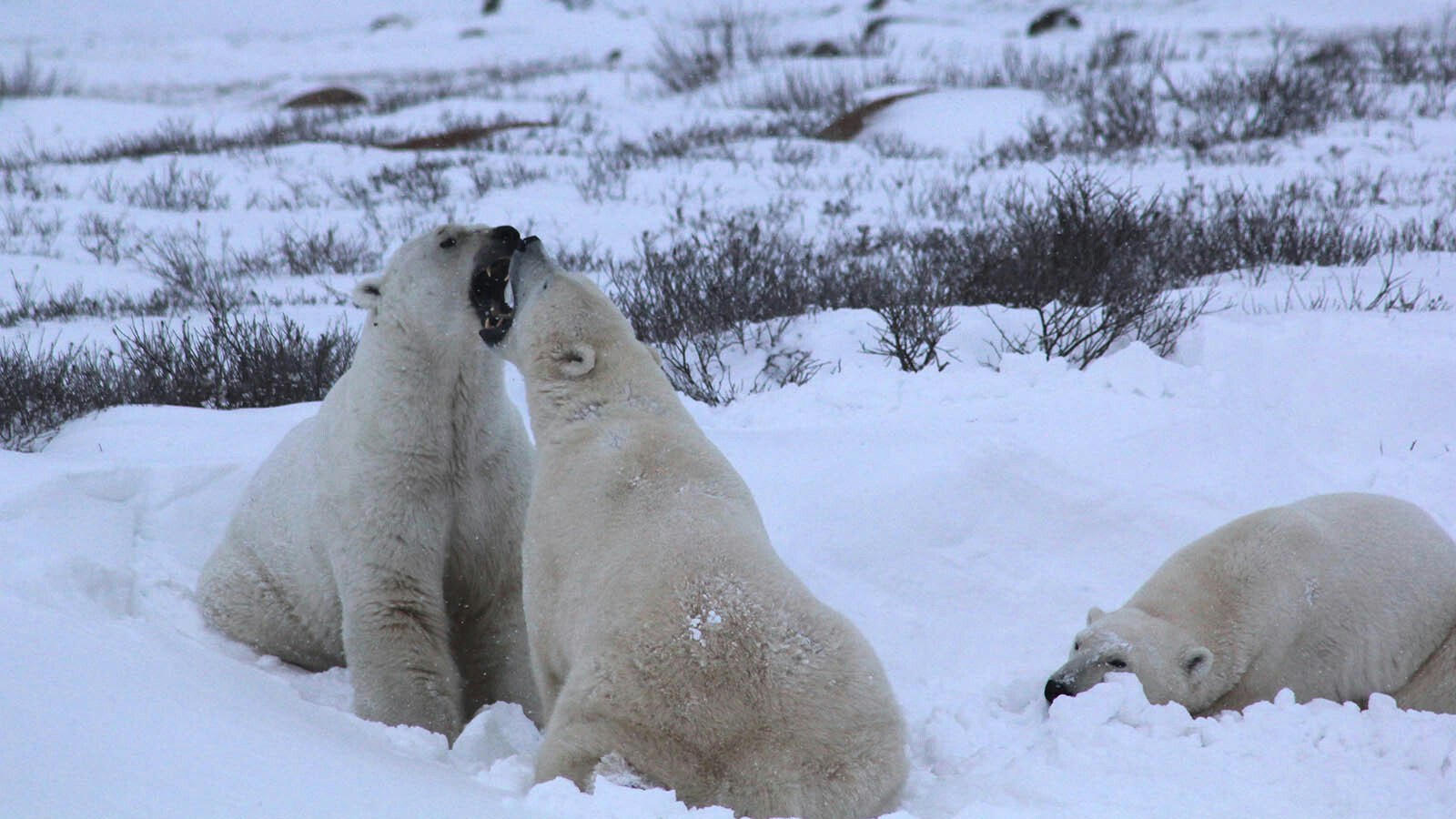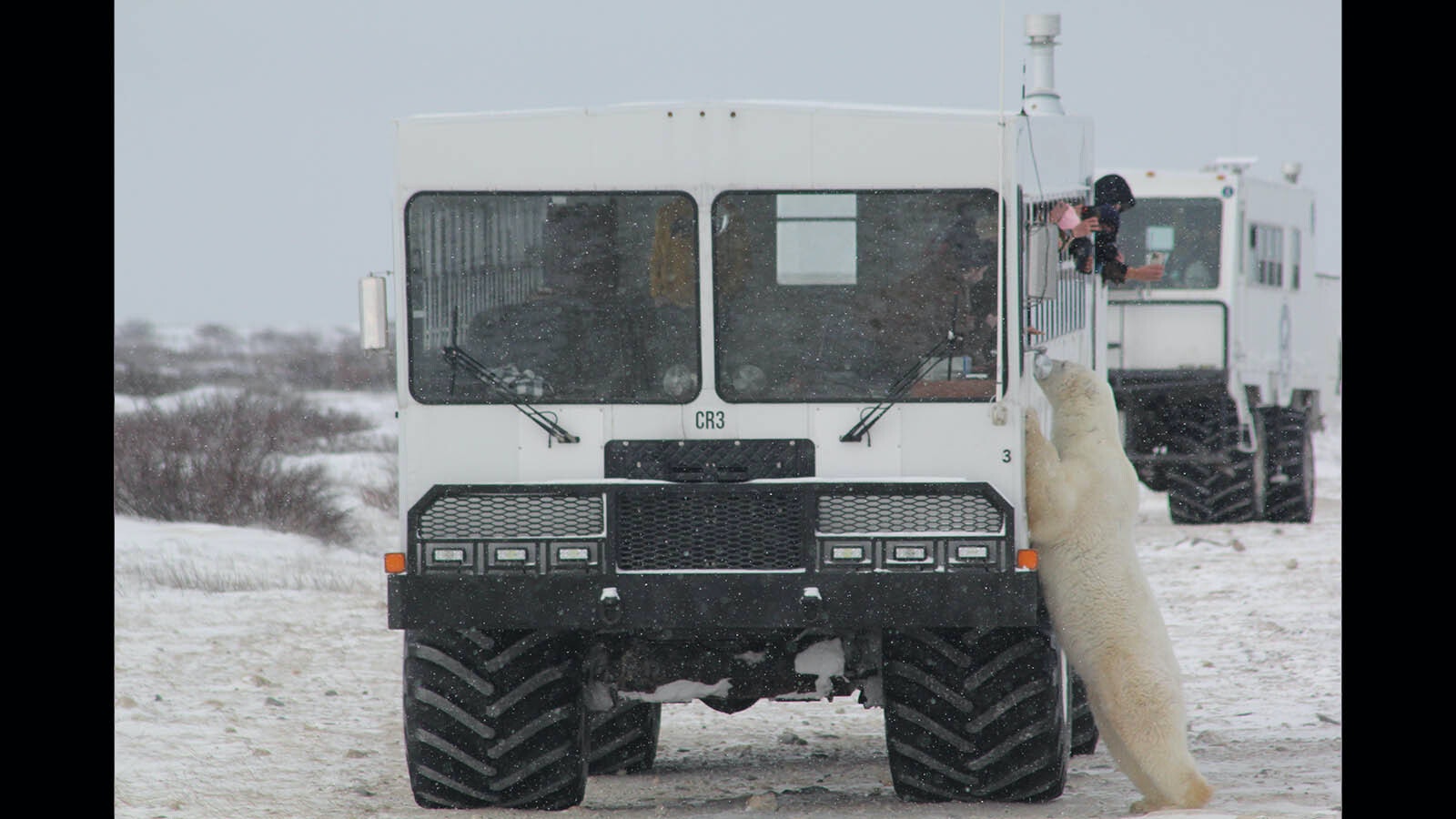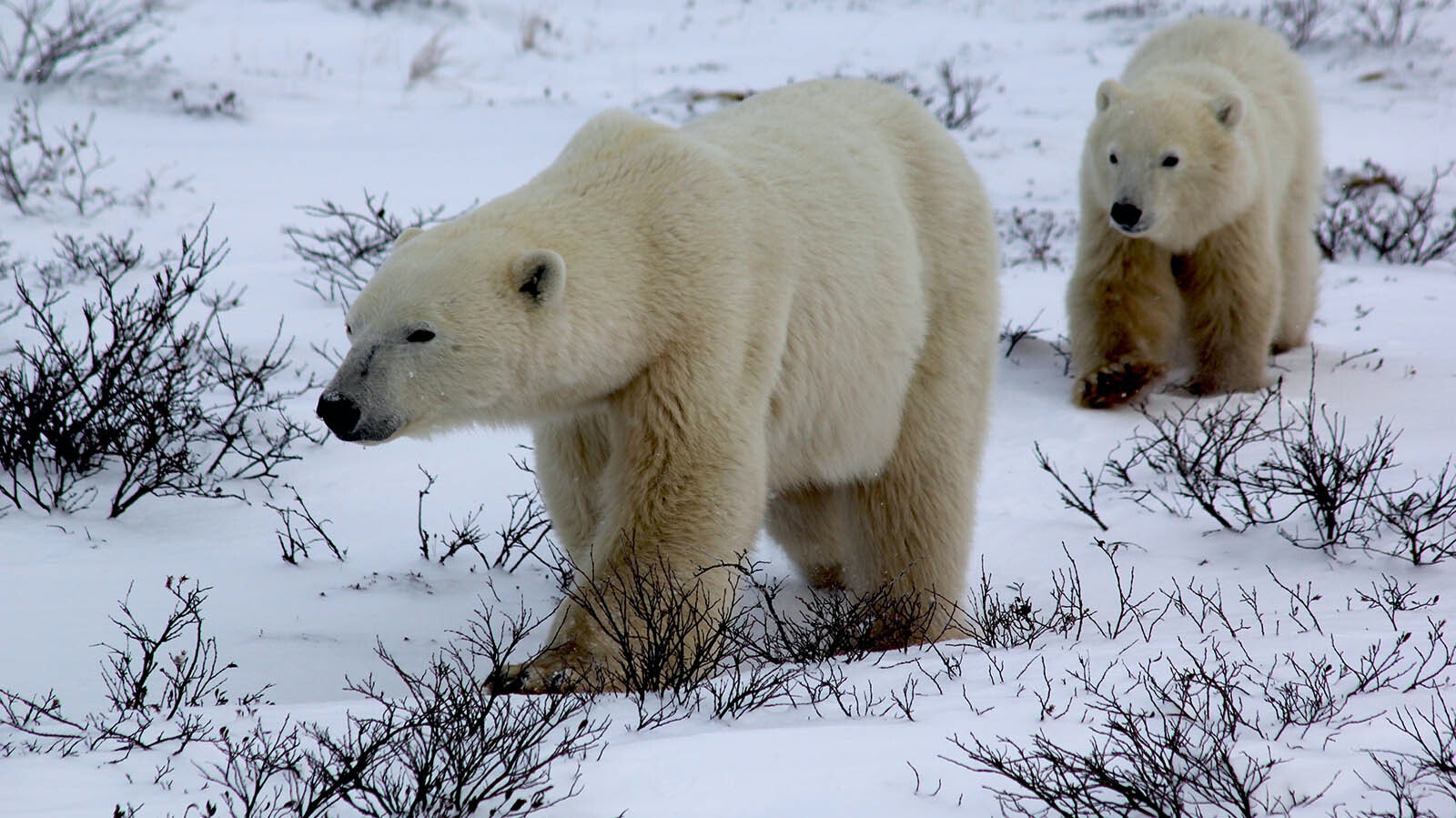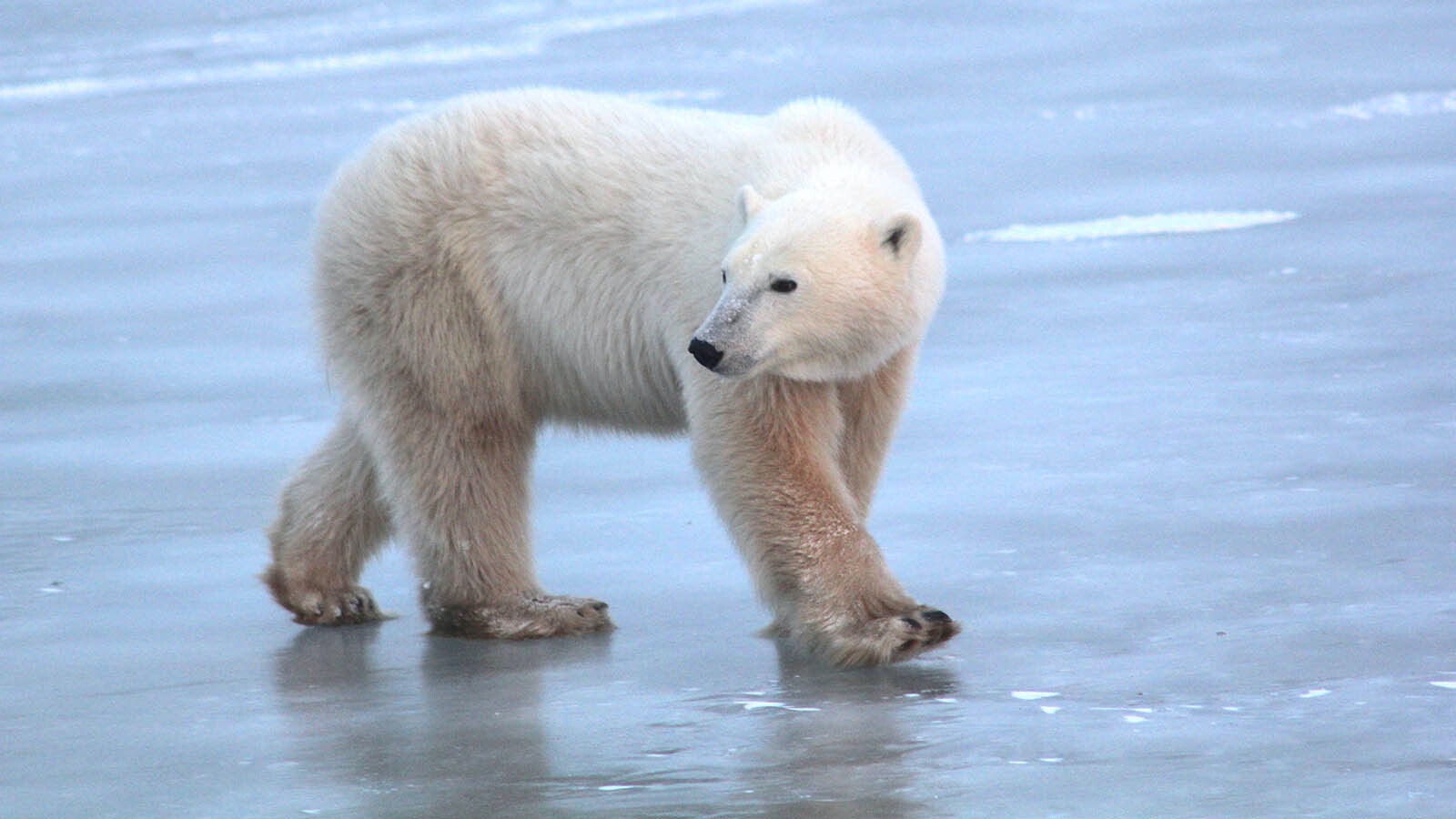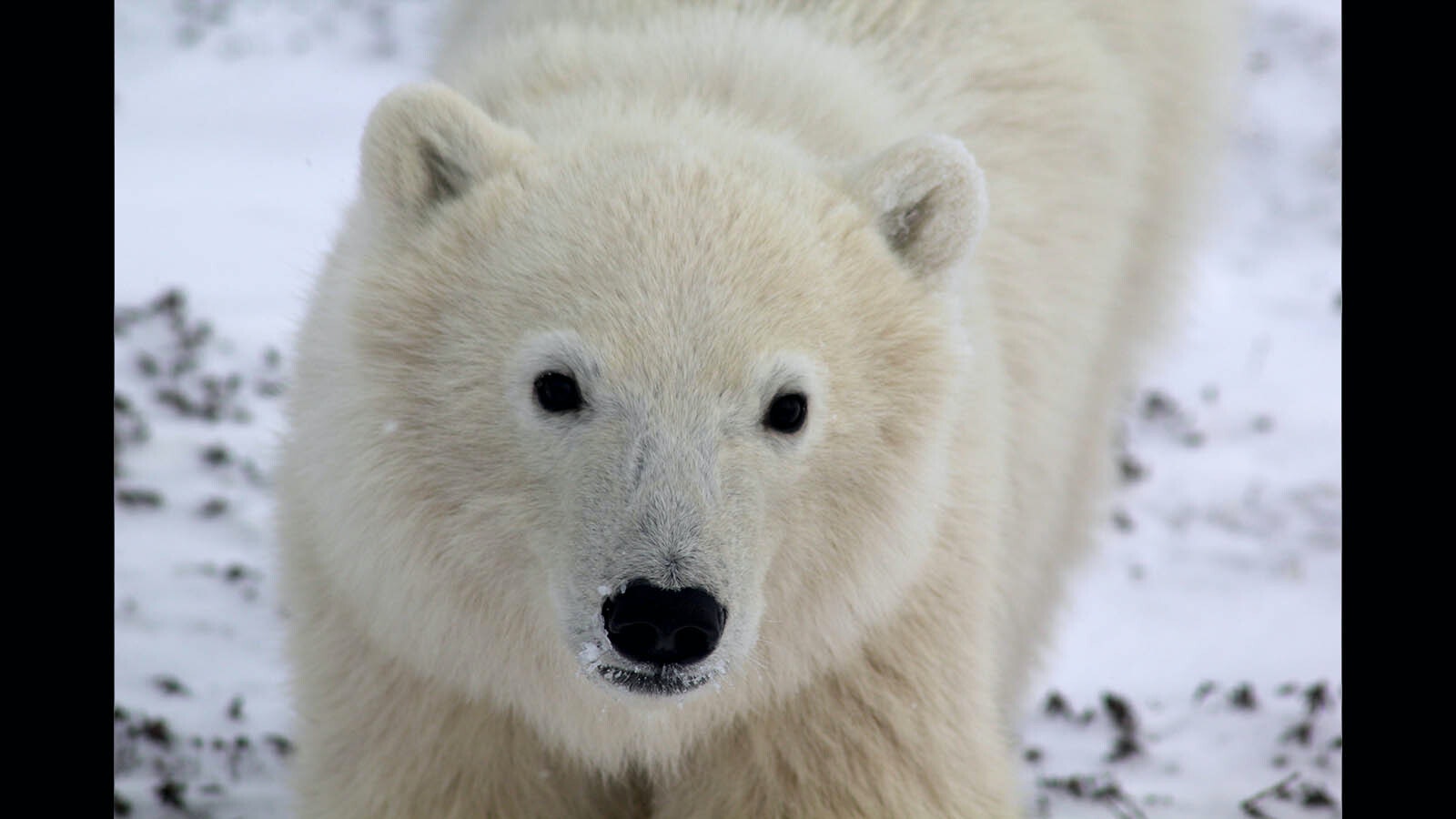My first sighting of a wild polar bear was a set of footprints on the ground outside the window of a unique cabin on the edge of Hudson Bay east of Churchill, Manitoba, Canada.
The track is obviously fresh. It’s compacted snow in the shape of a polar bear’s foot – all the snow around it is lost to the wind that blows almost constantly across the tundra.
About an hour later, as we were finishing dinner, a guide from the Tundra Buggy Lodge came into the restaurant and announced that two bears were fighting just outside the halo of the lodge.
In the lounge, with all the lights off, I could put my nose to the glass and see the bears, just shadows that looked like they were boxing.
The Tundra Buggy Lodge is similar to a train, with multiple cars used for different purposes. It has a crew car, a kitchen/dining car, a recreational vehicle and two sleeper cars. Bunk beds on the bunks serve as sleeping areas, providing privacy through double rows of curtains. Each bunk has a small window.
As I climbed into the bunk, my husband in the upper bunk whispered, “Candy, look out the window now!”
A polar bear is taking a stroll. He stopped and looked directly at me. He might be thinking, “I’m wild and free here, and you’re the one in the cage.”
It’s surreal and exciting.
700 polar bears
All thoughts of sleep disappeared as I put on my snow pants and heavy parka and headed out into the cold night to watch the bears from the viewing platform between the lounge and sleeping cars.
I had been waiting for years for the chance to see a polar bear in the wild and didn’t want to miss a moment of the experience.
But alas, it was cold in the subarctic tundra and I ended up back in my bunk.
There are approximately 700 polar bears living in the western quadrant of Hudson Bay near Churchill. They are one of the most studied polar bears on Earth.
They are somewhat predictable, spending nearly half the year on the edge of Hudson Bay.
Polar Bears International (PBI), headquartered in Churchill, has a rotating cadre of researchers, biologists and experts who observe, sometimes capture and tag bears and place radio collars on their heads to track its activities.
As apex predators, polar bears are not afraid of anything. They will kill dogs or people, but their prey of choice is the seals that live in the Hudson Bay, which they can only hunt when the water in the bay forms huge ice packs.
In mid-November, the day we visited Polar Bear International Headquarters, the polar bears were already on land and had not eaten for 154 days.
On the tundra they began to gather together in anticipation of ice floes and seal hunts.
Tundra SUV Transport
The way to see bears is in a large vehicle called a tundra buggy.
These strollers are built like a giant school bus, with oversized rubber tires so they can travel over uneven surfaces that are often wet, muddy or icy. They are tall, so when the polar bear stands up and leans against the stroller, it cannot reach the person holding the camera and binoculars.
Several companies with large vehicles take visitors to the Churchill Wildlife Management Area to see foxes, ptarmigans, sandhill cranes, moose and other animals and birds large and small. But their most coveted trip is to see polar bears in October and November.
Churchill WMA is adjacent to Wapusk National Park, one of the largest polar bear calving areas in the world. The only two females we saw, each with a cub, were heading toward Wapusk, which was probably a safer area for them, away from the male bears that congregated around the bay.
We traveled with Frontiers North and toured with the original Tundra Buggy Lodge company. They built the first off-road vehicle and started the business in 1979. Other companies are imitators. Even PBI relies on Tundra Buggy Lodge’s technology, location and experience.
Once you board one of these buggies, you don’t set foot on the ground again until the end of your trip – in our case four days later. The buggy stops at the Tundra Buggy Lodge for the night. But during the day they travel across the tundra in search of bears.
Not including bears seen from the hotel windows, we had nearly 70 bear sighting opportunities.
northern wrestler
Male bears behave much like teenage boys. They were constantly pushing (fighting), rolling, and wrestling each other. And sleep.
However, it is easy to understand that they are not teenagers because they do not eat.
From the time ice floes melt in early summer until they form again in late fall, bears live on land, relying on the fat resources they stored while hunting and eating fat seals during the winter.
If we ate the amount and type of blubber they depend on, it wouldn’t be long before we’d drop dead from clogged arteries. But polar bears are uniquely able to metabolize all of these fats.
As the ice forms—and even on our excursion to Hudson Bay it was growing significantly—you can almost see the bears smacking their lips at the thought of the feast that awaits them in the cold water.
When they looked bored and yawned, our guide told us they had their mouths wide open because that’s what they taste like. Their eyesight isn’t great, but they can smell seals through a few feet of ice floe…or a couple of Wyoming tourists standing on the back platform of a tundra buggy.
Hold on to your hat!
There are similarities to the tundra near Hudson Bay and Wyoming – wind!
It snowed there, but not as much as it did in the winter at the foothills of the Sierra Madre near our camp.
Generally speaking, the weather is colder, but certainly bearable with warm winter gear.
We brought heavy, warm snowshoes and didn’t really need them, although they were fine for walking the icy trails in the town of Churchill and Fort Churchill, a Parks Canada site where rangers stood guard with rifles.
Like Wyoming, much of Churchill’s economy is based on tourism. Polar bears are the main draw, but beluga tours are popular during the summer as these whales lay their eggs in the rivers of Hudson Bay.
During the dark days of winter, people go to see the Northern Lights, a light show that takes place at night 360 days a year. This doesn’t mean you’ll see the Northern Lights very often, as clouds often obscure the night sky.
One of the great things about visiting Churchill is that you don’t have to worry about whether the roads are open. They don’t have I-80. In fact, they had no roads leading into the town at all. The only way to get to Churchill is by plane or train.
Most of the roads used by the Tundra Buggy are old military roads at the Churchill Rocket Research Range, which were built in the 1950s when missile research was underway. The primary use of U.S. rockets near Hudson Bay is to study the atmosphere—especially the aurora. For many years, the complex has been Canada’s premier center for upper atmosphere research.
Approximately 870 people call Churchill home. I suspect half of them are seasonal tour guides and facilitators delivering weed and making beds for tourists.
The place is actually not much larger than Wyoming Riverside, only a few blocks long and wide. We were warned not to walk in the alleys where polar bears like to sleep. And tell us if you see a bear hiding in the nearest house, business or vehicle. Locals don’t lock their cars, so they can always take shelter if a bear gets too close.
polar bear prison
The primary responsibility of local law enforcement officers is to keep bears out of town.
The problem bear was captured and put in a polar bear jail for 30 days. The prison is dark, has solitary cells, and the only care the bears receive is water (they don’t eat anyway).
After 30 days, the bears were released away from the town. The goal is to make “town visits” uncomfortable so the bears don’t come back. Sometimes it even works.
PBI research shows the number of bears in the management area around Churchill is declining, from about 850 a decade ago to about 700 now. But that doesn’t mean polar bear numbers are declining overall.
On the contrary, polar bear populations have increased in all management areas over the past few decades. Our guide told us that Churchill bears are likely migrating from this area to other more remote areas to the north and west, which is why the numbers are constantly changing.
The biggest factor in the increase in polar bear numbers is the severe restrictions on hunting. In most cases, the only harvesting of polar bears is done by Aboriginal people.
However, bears face other risks. PBI emphasizes to all visitors to Churchill that climate warming is affecting ice floe – how long and how deep it exists. This in turn affects the seal hunt for polar bears. Without ice floes and seals, polar bears are doomed.
Of all the bears we saw on our trip, only one actually looked ready for a buffet of seals. He was large, probably old and skinny. For his sake, I hope the ice floe we saw will soon be solid enough so he can go out and fish for a fat seal for dinner.
Candy Moulton is a longtime Wyoming reporter who recently wrote a series on Wyoming Cowboy Hall of Fame members for Cowboy State Daily.
#Candy #Moulton #Explore #subarctic #tundra #polar #bears
Image Source : cowboystatedaily.com
